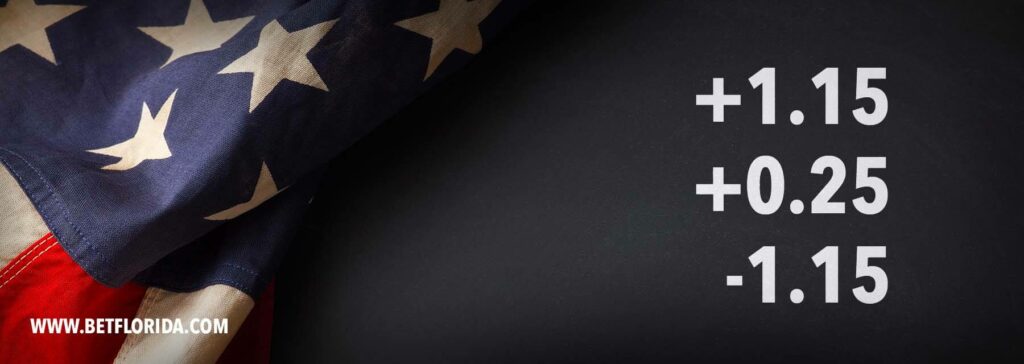The Latest NHL Odds
All the leading sportsbooks work hard to give you the most relevant markets and the best odds for all the current NHL events.
It’s always a good idea to check and compare odds from different online sportsbooks. This habit will help you to leverage the best ones for your bottom line.
Types of NHL Odds
If you’re a newcomer to NHL betting, it can be quite challenging to wrap your head around the NHL odds and understand the notions at first. However, once you learn the concepts, it will be a little easier to make sense of the numbers and possible winnings.
First of all, it’s essential to remember that sports odds are basic probabilities. If you remember your math lessons at school, you might also remember that there are several ways to describe probability.

Percentages, fractions, and decimals are all different methods to describe the same thing: part of a whole.
Now, if you take the outcome of a hockey game, it can also be represented in one of these three ways. We have American Odds, Fractional Odds, and Decimal Odds.
Each of these types is a method to display probabilities at the sportsbooks. The best online bookmakers will have a button or a drop-down menu to change the odds type.
American Odds
American odds are displayed as positive or negative numbers. The sign indicates if the team is the favorite (-) or the underdog (+).
If you bet on the underdog, the number shows the amount of money you would win if you wager $100. Conversely, if you bet on the favorite, you’ll have to risk the written amount to win $100.
Another important thing to remember is that American odds pay the amount won, plus the wager amount.
Let’s look at an example:
- Florida Panthers +118
- Tampa Bay Lightning -138
These lines indicate that the Tampa Bay Lightning are the favorite, and you would have to risk $138 to win $100. So, if you win, you’ll go home with $238 in total.
In case you bet $100 on the underdog, the Florida Panthers, and they managed the upset, you would win $118 + your initial stake of $100.
How to Calculate Probability for American Odds
As we have already mentioned, odds are probabilities of an outcome. Calculating the probability for American odds shouldn’t be difficult if you use the following equation:
(100 / (odds + 100)) * 100
Let’s take the odds for Tampa Bay Lightning and calculate the probability of the win: (100 / (138 + 100)) * 100 = 42%
Formula on How to Calculate Payouts
If you want to know how much money you’ll win if you wager a certain amount of money at the given odds, you can use the following formula:
Stake x (Odds/100) = Potential Profit
Potential Profit + Stake = Total payout
The potential profits from wagering $80 on the outcome of Tampa Bay Lightning winning will be 80 x (138/100) = 110.4. As the initial stake is added to the profit in the end, you’ll go home with $190.4 that day.
Fractional Odds
Fractional odds represent the payout-to-stake ratio. For example, if the Florida Panthers have the odds of 5/1 of winning the Stanley Cup this year, it means that if you bet $1 on that outcome, you’ll go home with $5.
Keep in mind that, unlike with the American odds, the initial stake is within the final number. Thus, betting $1 at 5/1 odds will give you $4 of pure profits.
How to Calculate Probability Based on Fractional Odds
You can convert fractional odds into percentages with the help of the following formula:
1 / (odds + 1) * 100
Thus, the probability of the Florida Panthers winning, in this case, would be 1 / ((5/1) + 1) * 100 = 16.6%
How to Calculate Payouts with Fractional Odds
If you want to back Florida Panthers betting $120 at 5/1 odds and want to know how much money you’ll win in case of a positive outcome, use the following equation:
(Stake x odds) + Stake = Total Payout
Total Payout – Stake = Profit
(120 x (5/1)) + 120 = 720
Your profit if Florida Panthers win the Cup will be $600 ($720 – $120), and this outcome will happen at 16.6% probability.
Decimal Odds
Decimal odds are the easiest way to calculate odds. This method is popular in European countries; that’s why it’s sometimes called “European odds.” Decimal odds show the amount you’ll win if you wager $1. Like the fractional odds, the amount includes the initial stake.
In general, (fractional odds + 1) will give you the decimal odds for the same line. So, if we convert the same 5/1 for Florida Panthers into decimal odds, we will get 6, which means that you win $5 of pure profits for every $1 you bet.
Calculating Probability for Decimal Odds
Use the following formula to determine the probability of decimal odds:
(1 / (odds)) * 100
So Florida Panthers have 1 / 6 * 100 = 16.6% chance to win the Stanley Cup this year.
How to calculate payouts with decimal odds
The formula to calculate the payouts for decimal odds is as straightforward as it could get:
Stake x odds = Total Payout
You might have guessed that betting the same $120 and using the decimal odds, will give you the same $720. But what if you bet $9? 9 * 6 = 54 is your total payout, and the pure profit is $45.
Understanding Odds
As we have already established, the odds are probabilities of a specific outcome. In other words, you wager an amount of money on an event that will happen in the given percent of the time.

Now that you’re familiar with the types of odds, you can dive into the game-specific NHL odds. There are a lot of different odds for each given game, so it is essential to understand what outcomes they represent.
Read on to explore the types of lines and markets the bookmakers offer for NHL games.
Odds in a Money Line
Moneyline odds are the most straightforward ones you can come across. You just make a guess (or an educated guess) on which team will win and which one will lose.
Moneyline odds don’t take into account the number of goals scored during the game or by how many goals the team won. The only thing that matters is who the winner is.
As we have already mentioned, the odds for favorites bear the minus (-) sign in front of the odds index, and underdogs will have a plus (+) sign. So, if you bet on a favorite with odds of -140, you’ll have to risk $140 to win $100. Betting on an underdog with odds of +170 will require risking $100 to get $170.
There are situations when the bookmaker values both teams at the same odds for winning, so you’ll see the same number with the same sign for both teams.
Point Spread Odds
Point spread betting in the NHL is called “Puck line.” These odds describe the number of goals by which the winner had an advantage over the loser. The “Puck line” in hockey is usually positive or negative 1.5.
The number of the point spread is smaller because, unlike basketball, for example, ice hockey doesn’t typically end in huge totals and goal differences between the winner and the loser.
For your bet to win, the favorite will have to win by 1.5 or more goals. As there are no half points in ice hockey, there should be a positive difference of 2 or more goals between the teams. If you bet “puck line” on the underdog, you state that the underdog won’t lose by 2 or more goals.
The best part of betting on “the line” for an underdog is that your bet can win, even if the team loses. Imagine you bet on the underdog +1.5 (-120), and the game ended 3 (favorite):2 (underdog).
This outcome would mean that the team only lost by one point. This means that you risked $120 and won $100.
Odds in Point Totals
Betting on totals is the same as guessing the total number of goals in a given game. It doesn’t matter which team wins or loses.
Hockey is a game of small numbers, that’s why the usual ballpark for an NHL totals odds is 5.5. As usual, the positive 5.5 indicates the favorite team, and the negative 5.5 indicates the underdog.
Point total, like “puck line,” will have a second number in the parentheses, which indicates the payout. Totals odds are also known as Over/Under bets. To win an “under” bet, the number of goals in a game should be 5 and fewer. The game should end on 6 goals or more if you want to win an “over” bet.
Futures Odds
Futures odds or outright odds are quite simple. The bookmakers put out odds for winning the tournament at the beginning of the season. For the NHL, the Stanley Cup futures odds, for example, come out sometime in October, when the regular season is just picking up.
The teams that are least likely to win the Stanley cup can have crazy odds of +25000 attached to their names in the “Futures odds” table. This number means that you’ll earn $25000 + your initial stake of $100.
Unique Odds in the NHL
Odds that are based on game outcomes work similarly in different sports. However, every sport has a set of markets that are unique to the gameplay. They can also be very specific to a given game, team, or player. These are the most fun markets to try betting on.
These unique odds are called proposition bets and can refer either to one player (player-specific) or to the gameplay and teams (game-specific). They can also require skill and game knowledge to win the bet or be based on guesswork.

An example of a skill-based line would be “Which team will score the first goal?” Of course, you can outright guess the outcome, and there is always a chance you’ll be right.
However, you’ll have to know the teams and the players and take into account which players are taking part in the game at that point. Further, you should even know about their prior injuries to predict the outcome more precisely. All that information will turn the game of chance into an educated guess.
An example of an unskilled bet would be “Will the starting coin toss land on heads or tails?” No additional knowledge would be able to increase your chance of guessing the outcome of this bet.
Player-Specific Odds
The most common player-specific lines in hockey are the “Goalscorer markets” and the “Player point.”
While betting on goalscorer markets, you’re trying to determine who will score first, last, or anytime during the game. You’ll need luck and a bit of knowledge to improve your chances of winning this bet.
In hockey, it can also be very profitable to guess which player assists on goals. Betting on player point odds is an excellent opportunity to discover new talent within the team. The assist might come from the usual suspects or from a player you wouldn’t have thought about.
Game-Specific Odds
Game specific bets can either be based on gameplay (empty net, first-period betting, grand salami) or be about team outcomes during a specific game, say the Stanley cup finals.
Empty net is a chaos strategy employed at the end of the game to leverage an additional player for the last attack. This move has become so commonplace that the bookmakers started including it in the props.
The Icehockey rule that say if you pull your goalkeeper, you can put an extra player on the ice, is the rule that creates this empty net betting possibility.
First-period betting is a type of hockey-specific odds that utilizes all the usual markets like puck line, and moneyline, but all the outcomes are valid only for the first period of a given game.
The Grand Salami is an NHL-specific bet. The regular season consists of 82 games, some of which can happen on the same day. Betting on the total number of goals for a given day is the Grand Salami bet.
As you might know, the Stanley Cup final is one of the most significant events for hockey fans and bettors. The buzz almost certainly opens the opportunity for some exclusive markets for the game.